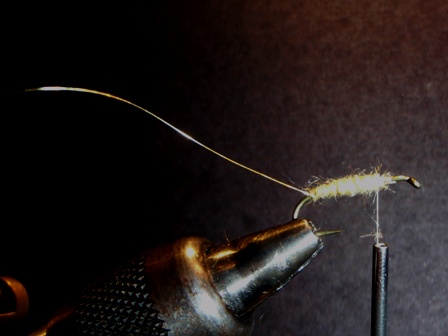Description
I’ve recently designed a new series of three
flies for the ubiquitous “Little Yellow
Stonefly” that we all (sometimes) know and
(always) love. I say “sometimes” when it
comes to “know” because this little bug may
well be the most mistakenly identified of
all of the aquatic insects that we consider
to be our fish staples. While guiding, I’ve
heard clients refer to them as terrestrials
(lacewings, for example), mayflies (PMDs in
particular), and light-colored caddis.
That’s not a criticism, by the way—it’s easy
to mistake the Sally for other small
aquatics, especially when it’s breezy. But
it’s also important to learn how to “know”
Sally when she’s (or he’s) the one doing the
flying around in your little piece of
heaven. Knotting on a PMD imitation or an
Elk Hair Caddis, or the wrong kind of nymph
or emerger, will beget only frustration
because, at least in my experience, fish
keying on Sallies are very selective.
The Sally nymph was featured in the
September, 2010 Leader. I’ll feature the
adult in a future article. For this article
I’m presenting the Swimming Starling
Sally, which is a soft hackle style
pattern that could represent the subspecies
that actually hatch in the water column
(i.e., an emerging life stage), or simply a
nymph that is drifting along after having
become dislodged from the rocks. Don’t think
in terms of mayfly emergers, because that is
an entirely different concept.
There are a number of ways of fishing soft
hackle flies. One way would be to suspend it
by itself under an indicator with a fairly
long tippet (6-9’) and a small split shot,
cast the rig upstream, mend into a dead
drift, and transition to a swing after the
rig passes your position. A second way (my
preferred technique for pocket water) would
be to attach it to the bottom fly in a
short-line rig with 14-16” of 5x
fluorocarbon and fish it as a “stinger.”
This means casting upstream, using a regular
short-line drift until the rig passes your
position, and then allowing it to swing at
the end of the drift. A third method would
be to fish it in traditional soft-hackle
swing style on a long leader (9-12’) with 5x
fluorocarbon at the tip. In all three
methods, I will utilize the “Leisenring
Lift” technique at the end of the drift
to mimic an insect rising in the water
column.
So, let’s tie up a few.
Tying Instructions
|
1.
Starling feathers from the neck area have an iridescent black shine
and a tannish tip. These are the
feathers you should look for.
2.
To prepare a feather for a soft-hackle fly, there are several
methods that have been written
about. I prefer to follow these
steps:
3.
Strip the fuzz from the butt end of the feather, but don’t cut the
stem.
4.
Rib the body with 4 or 5 turns of the gold wire and tie off the
wire at the front of the body.
5.
Dub a thorax that is somewhat more robust than the body. The
purpose of this step is to create a
thorax appearance but also to backstop
the soft hackle so that it doesn’t just
flatten out against the body during the
drift. In turn, this allows the hackle
to “swim” as the fly drifts. It is
important that you leave at least two
hook-eye widths open behind the eye so
that the hackle (next 2 steps) can be
properly wound around the hook.
6.
Prepare a starling feather and tie it in by its tip, just in front
of the thorax. Since the fly is
designed in the soft-hackle
style, the concave side of the
feather should face the rear of
the hook.
7.
Wind the feather around the hook at least 3 times, sweeping the
barbules back on each turn. Tie
the feather off just behind the
hook eye, trim the excess, and
wind the thread in close wraps
rearward to help sweep the
hackle backward. Whip finish and
apply a small drop of super glue
to the head.
|


 |
|
Tying Tips
1. Starling feathers from the neck area have an iridescent black shine
and a tan-ish tip. These are the
feathers you should look for.
2. To prepare a feather for a soft-hackle fly, there are several
methods that have been written
about. I prefer to follow these
steps:
3.
Strip the fuzz from the butt end of the feather, but don’t cut the
stem.
4.
Isolate the feather’s tip by grabbing it with pointed tweezers and
sweeping the remaining barbules
rearward.
5.
Tie the feather in using the isolated tip as a tab.
Now go crank out a few of these
gems and….

|
|

